-

人教版新目标初中英语九年级下册By the time I got outside, the bus had already left教案
Ⅰ. Teaching Aims and Demands1. Knowledge Objects(1) Key Vocabularyoversleep(2) Target LanguageWhat happened?I overslept. And by the time I got up, my brother had already gotten in the shower.2. Ability Objects(1) Teach the students to use the new words.(2) Train the students to narrate past events with the Past Perfect Tense.(3) Train the students' listening and speaking skills with the target language.3. Moral ObjectIt’s a good habit to go to bed early in the evening and get up early in the morning. So you’ll never be in a hurry in the morning.Ⅱ. Teaching Key Points1. Key Vocabularyoversleep2. Target LanguageNarrate past events with the Past Perfect TenseⅢ. Teaching Difficult Points1. Train the students to narrate past events with the Past Perfect Tense.2. Train the students to understand the target language in spoken conversation.Ⅳ. Teaching Methods1. Thinking of examples from the students' real lives.2. Making sentences by looking at the pictures.Ⅴ. Teaching AidA tape recorderⅥ. Teaching ProceduresStep I Revision1. Revise the language points in Unit 8.Ask some questions like this: What volunteer work would you like to do?Help the students to answer, I’d like to…/I love to…/I hope to2. Practice the dialogue in Activity 3c on page 62 again. Get students to role play the similar dialogues with the following.

人教版新目标初中英语九年级下册Rainy days make me sad教案
1. 教材分析本单元以how do things affect you?为话题, 从颜色、天气、音乐、广告、产品等方面谈论了外界事物如何影响人的心情。要求学生掌握表达某物或某事给人带来的感觉、看法或影响等。共设计了四个部分的内容:Section A 该部分有4个模块:第一模块围绕Which restaurant would you like to go to?这一话题展开思维(1a)、听力(1b)、口语(1c)训练;第二模块围绕How does music affect you? 进行听力(2a-2b)、口语训练(2c);第三模块继续围绕how do colors in the restaurant affect you这一话题展开训练,训练形式为阅读和问题体验(3a)和小组活动(3b);第四模块仍就How do things affect you这一话题以调查的形式展开讨论。Section B该部分有4个模块:第一模块围绕产品广告对人们的影响这一话题以“配对”(1a)与“列举”(1b)两种形式展开训练;第二模块继续围绕How do things affect you? 进行听力(2a-2b)、口语对话训练(2c);第三模块围绕“Advertising”这一话题展开阅读(3a-3b)和写作(3c)训练;第四模块围绕How posters affect you这一话题以口语训练形式展开小组活动。

人教版新目标初中英语九年级下册Could you please tell me where the restrooms are教案
Step Ⅰ RevisionCheck homework. Ask a few students to read the article in 3a.Then ask a few students to read their guides.Step Ⅱ Part 1Look at the words in the box. Ask a student to read them. Make sure the students understand the meaning of the words. You are to fill in the blanks with the words. In some cases, students may need to use another form of the word, for example adjusting for tense or subject/ verb agreement.Ask students to fill in the blanks on their own.Check the answers. Step ⅢPart 2Go through the instructions with the class.Look at the example with the students.Ask students what the answer would be.Ask a student to read the question and answer it.Excuse me, could you tell me where the bank is, please?The bank is across the street from the shopping malt.Get students to complete the work in pairs.Check the answers. Ask a few students to read their questions.Step Ⅳ Just for Fun!Ask all the students to read the conversation. Ask: What is funny about this cartoon? Help students to explain. A Martian is a person from the planet Mars.There is no such thing as Martian food on Earth, and the clerk looks silly because he is trying to think of where there is a Martian restaurant.Invite some pairs of students to present this conversation to the rest of the class.Step Ⅴ Summary and HomeworkIn this class, we’ve done much writing practice using the key vocabulary words and the target language presented in this unit. After class, please finish the questions in 2 in your exercise books. Then finish the exercises on pages 47~48 of the workbook as well.The Seventh Period Ⅰ Teaching Aims and Demands1. Knowledge Objects(1) Key Vocabularyimage, adventure, jealousy, hero, crime, journey, brave, no longer, show interest in, take it easy, become interested in, plain looks(2)Text:Grown-ups like cartoons, too.2. Ability Objects(1) Fast-reading to get a general idea of the text.(2) Careful-reading to get the detailed information in the text.

人教版新目标初中英语九年级下册I’ll help clean up the city parks教案
Talk about offering help (P60)I’ll help clean up the city parks.A: I’d like to work ...B: You could help ...Talk about ways to tell people about the Clean-Up Day (P61)We need to ...We can’t ...I’ll ...Talk about the work the volunteers do (P62)These three students all volunteer their time to help other people.Somebody loves to ... / helps ... / plans to ... / wants to ...A: What do you like doing?B: I like ... A: What kind of volunteer work do you think I could do?B: You could ...1. 重点词汇advertisement, fix, repair, pleasure, blind, deaf, shut, carry, specially, fetch2. 认读词汇hunger, homeless, cheer, clean-up, sign, establish, major, commitment, elementary, veterinarian, coach, similar, call-in, strategy, disabled, organization, unable, support, appreciate, donation, part of speech, pronoun, adverb, preposition, conjunction, donate, Jimmy, Sally3. 词组clean up, cheer up, give out, put off, set up, think up, take after, fix up, give away, put up, hand out, work out, at once

人教版新目标初中英语九年级下册We’re trying to save the manatees教案2篇
本单元主要围绕着有关濒临灭绝的动物这一话题,学习了应该怎样保护我们的环境,以及就某一问题展开辩论。目标提示语言目标能够运用所学知识,就某一问题展开辩论。认知目标1、复习一些语法:现在进行时、一般现在时、用used to 表示一般过去时、现在完成时、一般过去时的被动语态。2、学会表达同意和不同意。3、学会以下基本句型:We’re trying to save the manatees.Manatees eat about 100 pounds of food a day.There used to be a lot of manatees.In 1972,it was discovered that they were endangered.Some of the swamps have become polluted.情感目标了解一些濒临灭绝的动物的生活习性和濒临灭绝的原因,教育学生应该如何保护环境。教学提示充分利用多媒体等教学设备,创设与本课话题相关的情境,如各种不同种类的动物、动物园以及有关环境的画画等等。围绕着本单元的教学目标,设计一些贴近学生实际的教学任务,如让学生谈论自己最喜欢的动物,如何拯救濒危动物,如何保护环境等等。让学生根据所学知识,就动物园是否对动物有利以及其他的话题进行辩论。

人教版新目标初中英语九年级下册You’re supposed to shake hands教案
教学目标:1. 掌握本单元一些重点词汇的写法和用法。2. 学会自如谈论餐桌礼仪。Step 1 RevisionAsk some students to retell the customs at the table in France in the passage in 3a.Step 2 Self checkPart 1. Fill in each bland with the correct word given. Students do the exercises by themselves at first. Then check the answers. Ask the students to comprehend the sentences and help them point out uses of some words, like “arrive (at / in) sw., spend time / money on sth , spend time / money (in) doing sth.”Part 2. Read about Fan Ling’s experience in a western restaurant. Understand the passage. Point out some key points in the passage.1. be / get used to doing sth. 习惯做某事2. begin with = start with 以….开头3. crowd v. 挤满,塞满 the crowd 人群 crowded adj. 拥挤的Then students discuss about how she would solve her problem. Ask some to share their stories with others.Part 3. Complete the crossword by looking at the sentences on the left. Then check the answers.

人教版新目标初中英语七年级下册Where is the post office教案2篇
Period 2 (3a----Section B 2c)Preview(Pre-task): Key points: What laAdd another information about their pen pals----their language on the cardnguage does she/he speak?She/He speaks....Does she/he have any brothers and sisters? Does she/he speak English?Preview(Pre-task): Add another information about their pen pals----their language on the cardKey points: What language does she/he speak?She/He speaks....Does she/he have any brothers and sisters? Does she/he speak English?Step 1 Revision1.Revisionand dictation of the new words 2.Revise the drills they learned yesterday.(by pairwork and grammar exercise)Step 2 Leading-inT has a conversation with one student. The conversation is following:---Do you have a pen pal?---Yes, I do.---What's your pen pal's name? ---His/Her name is....---Where is your pen pal from? ---He/She is from...---Where does he/she live? ---He/She lives in....---What language does he/she speak?He/She speaks...Write the new words on the Bb. They are following: EnglishChineseJapaneseFrenchStep 3 LearnLearn the new words with the whole class.Finish 3a with the students3b Pairwork T still does an example with one student Then the Ss practise in pairs. The example is following:--Curry Muray is my pen pal. He is from the United States.---What language does he speak?

人教版新目标初中英语七年级下册I ’d like some noodles教案
教学过程Step 1: warming-up Sing a song---------“food and drink” Step 2: Revision1 Dictation2 Revise: What kind of noodles would you like?I’d like …What size bowl of noodles would you like?I’d like…Step 3: Presentation1 show pictures of food, ask students say the words.2 Students read the newspaper ad in 3a. Fill in blanks with words in the box. Then read the ad together, the teacher explains some difficult language points.3 Check the answers Step 4 PracticeAsk students to finish 3b in the same way according to 3a. Students read the short passage and fill in the blanks .At last, check the answers.Step 5 productionAsk students to write their own ad for dumplings, noodles, drinks, and other foods they know. Then ask students to read their partner’s ad. Then order food and drink from their partner.Step 6 Home workGroup work – make an ad about “food and drink”

人教版新目标初中英语七年级下册Where is your pen pal from教案
2.1Match the country with the language.Step II Reading3a? let the students read the letter fast and answer the questions.? Let the students ask more questions about the letter as possible as the can.Step III Writing3b.Step IV. Pairwork2cStep V Listening2a, 2bStep V. HomeworkExercises book(1) P3Exercises book (2) P3Period FourStep I . Dictate the words and sentences in Unit1.Step II. Self-checkStep III. Check the answers for Exercises book in the unit.Step IV. Home workRevise and preparation for unit 2.教学反思:通过本单元的学习,学生基本可以谈论人们的国籍,居住城市及其所说的语言,通过书信方式去介绍自己并寻找笔友。但在涉及到国外的一些城市时,学生对这方面的知识相对欠缺,能介绍的城市并不多,也反应出学生课前预习不充分,这跟学生学习条件也有关,大多数学生无法通过网络获取所需信息。因此,在以后的教学中要多指导学生通过计算机网络获取信息,拓宽知识面。
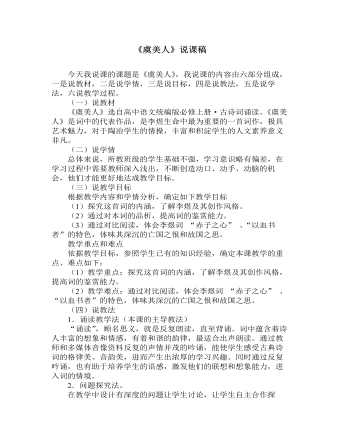
古诗词诵读《虞美人(春花秋月何时了)》说课稿 2021-2022学年统编版高中语文必修上册
(一)说教材 《虞美人》选自高中语文统编版必修上册·古诗词诵读。《虞美人》是词中的代表作品,是李煜生命中最为重要的一首词作,极具艺术魅力,对于陶冶学生的情操,丰富和积淀学生的人文素养意义非凡。(二)说学情总体来说,所教班级的学生基础不强,学习意识略有偏差,在学习过程中需要教师深入浅出,不断创造动口、动手、动脑的机会,他们才能更好地达成教学目标。(三)说教学目标根据教学内容和学情分析,确定如下教学目标(1)探究这首词的内涵,了解李煜及其创作风格。(2)通过对本词的品析,提高词的鉴赏能力。(3)通过对比阅读,体会李煜词 “赤子之心” 、“以血书者”的特色,体味其深沉的亡国之恨和故国之思。
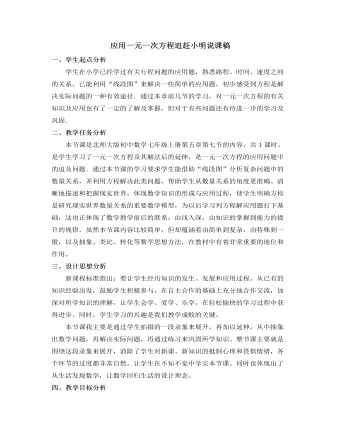
北师大初中数学七年级上册应用一元一次方程追赶小明说课稿
目的:进一步理解追击问题的实质,与课程引入中的灰太狼追喜羊羊故事呼应,问题得到解决。环节三、运用巩固活动内容:育红学校七年级学生步行郊外旅行,1班的学生组成前队,步行速度为4千米/小时,3班的学生组成后队,步行速度为6千米/小时,1班出发一个小时后,3班才出发。请根据以上的事实提出问题并尝试回答。问题1:3班追上1班用了多长时间 ?问题2:3班追上1班时,他们离学校多远?问题3:………………目的:给学生提供进一步巩固建立方程模型的基本过程和方法的熟悉机会,让学生活学活用,真正让学生学会借线段图分析行程问题的方法,得出其中的等量关系,从而正确地建立方程求解问题,同时还需注意检验方程解的合理性.实际活动效果:由于题目较简单,所以学生分析解答时很有信心,且正确率也比较高,同时也进一步体会到了借助“线段图”分析行程问题的优越性.
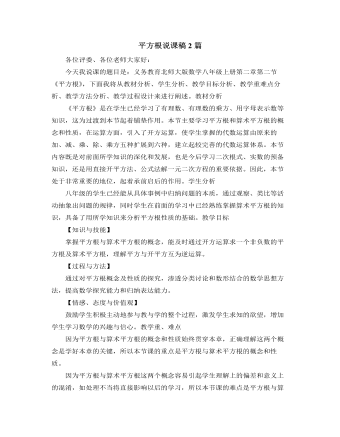
北师大版初中八年级数学上册平方根说课稿2篇
让学生先独立解决⑴题,再小组交流⑵题的答案,找到解题的方法.2、例2,例3是对平方根概念的巩固与拓展,在例2中由于学生还不熟于平方根的表示方法,所以应在平方根的概念和±号上加以明确,而例3则要把握平方根概念的本质,根据该数的正负或0来确定其平方根,这部分内容可用板演或展台展示结果的方式进行,让学生独立完成,应给予恰当的评价.3、最后,我又设计了一道辨析题:在做一道求4的平方根的题目时,小明说:“4的平方根是2”,小红说:“4的平方根是-2”,小强说:“2是4的平方根”小芳说:“-2是4的平方根”,请问他们的说法正确吗?通过这道题目,使学生在熟悉平方根概念的基础上更加深理解,同时对以往五种运算中从未出现过的一题两解的现象作出了解释,使学生明白了一种整体与局部的关系,再一次突出了重点.

北师大版初中八年级数学上册一次函数图象的应用说课稿
本环节运用了一个阶梯式的问答方法,帮助突破本节课的难点。同时,从具体的实际问题入手,由特殊问题到一般规律的揭示,不仅解决了难点问题,而且从另外一个角度讲也渗透给了学生的数形结合思想,还有利于学生主动探索意识的培养。4、自主评价本环节主要是应用本节课所学的知识以及所积累形成的学习经验和体验解决问题的过程,即课堂巩固训练。在练习题的选择上,由简单到复杂。先是结合图象获取信息进行简单的填空和选择,此题属于A组题型,检验学生的掌握情况;然后进行了一道B组题,关于“一次函数与一元一次方程的关系”知识点的灵活运用,进一步通过练习体会它们的关系。5、自主发展:最后一道则是特殊的区别于之前所学习的分段函数练习,发散学生思维问题的训练。让学生体会分段函数的特点,并掌握求分段函数解析式的方法。
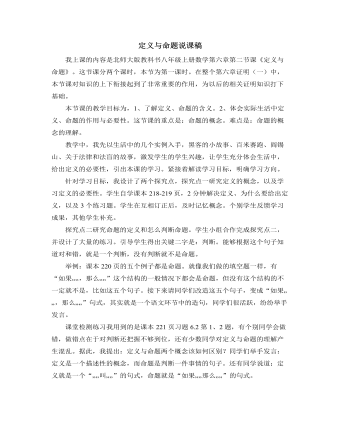
北师大版初中八年级数学上册定义与命题说课稿
接下来请同学们改造这五个句子,变成“如果??,那么??”句式,其实就是一个语文环节中的造句,同学们很活跃,纷纷举手发言。课堂检测练习我用到的是课本221页习题6.2第1、2题,有个别同学会做错,做错点在于对判断还把握不够到位,还有少数同学对定义与命题的理解产生混乱。据此,我提出:定义与命题两个概念该如何区别?同学们举手发言:定义是一个描述性的概念,而命题是判断一件事情的句子。还有同学说道:定义就是一个“??叫??”的句式,命题就是“如果??那么??”的句式。在教学中,学生对定义与命题的把握还是比较清楚的。大部分学生可以口头完成导学案设计的题目。能够迅速的把一个命题转化成“如果?那么?”的形式.利用疑问句和祈使句的特点,判定不是命题的语句.迅速的掌握情况还是比较可以的。
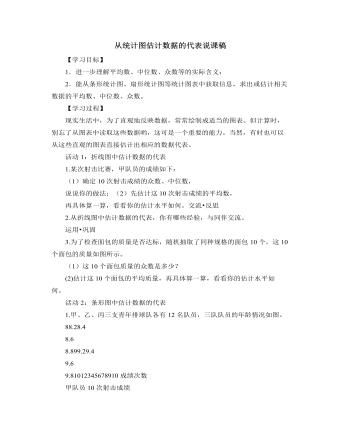
北师大版初中八年级数学上册从统计图估计数据的代表说课稿
1.小明调查了班级里20位同学本学期计划购买课外书的花费情况,并将结果绘制成了下面的统计图.(1)在这20位同学中,本学期计划购买课外书的花费的众数是多少?(2)计算这20位同学计划购买课外书的平均花费是多少?你是怎么计算的?反思?交流*(3)在上面的问题,如果不知道调查的总人数,你还能求平均数吗?2.某题(满分为5分)的得分情况如右图,计算此题得分的众数、中位数和平均数。活动4:自主反馈1.下图反映了初三(1)班、(2)班的体育成绩。(1)不用计算,根据条形统计图,你能判断哪个班学生的体育成绩好一些吗?(2)你能从图中观察出各班学生体育成绩等级的“众数”吗?(3)如果依次将不及格、及格、中、良好、优秀记为55、65、75、85、95分,分别估算一下,两个班学生体育成绩的平均值大致是多少?算一算,看看你估计的结果怎么样?*(4)初三(1)班学生体育成绩的平均数、中位数和众数有什么关系?你能说说其中的理由吗?

北师大版初中八年级数学上册二次根式说课稿
有意义,字母x的取值必须满足什么条件?设计意图:通过例题的讲解,使学生加深对所学知识的理解,避免一些常见错误。而变式练习设计,延续的例题的风格,一步一步,步步深入,本节课的教学难点就在学生的操作活动中迎刃而解了。对提高学生对所学知识的迁移能力和应用意识,激发好奇心和求知欲起到良好效果。(五)、巩固运用,提高认识1、通过基础训练让学生体验学习的成就感。2、应用拓展:增加难处,再次让学生联系以前的知识,增强学生的数学应用意识。(六)、总结评价,质疑问难这节课我们学习了什么?设计意图:学生共同总结,互相取长补短,学生在畅所欲言中对二次根式的认知得到进一步的巩固升华。五、板书设计.采用纲领式的板书,使学生有“话”可说,有“理”可循,在简单板书设计中使学生体会到数学的简洁美。
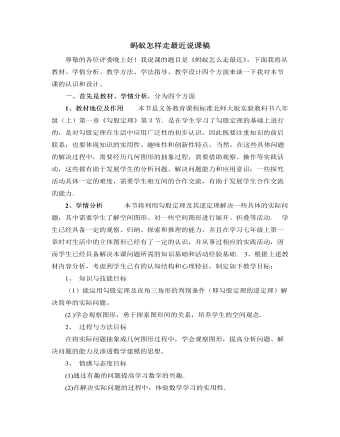
北师大版初中八年级数学上册蚂蚁怎样走最近说课稿
学生以小组为单位,合作探究蚂蚁爬行的最短路线,充分讨论后,汇总各小组的方案,在全班范围内讨论每种方案的路线计算方法,通过具体计算,总结出最短路线。让学生发现:沿圆柱体母线剪开后展开得到矩形,研究“蚂蚁怎么走最近”就是研究两点连线最短问题,引导学生体会利用数学解决实际问题的方法:建立数学模型,构图,计算.意图:通过学生的合作探究,找到解决“蚂蚁怎么走最近”的方法,将曲面最短距离问题转化为平面最短距离问题并利用勾股定理求解.在活动中体验数学建摸,培养学生与人合作交流的能力,增强学生探究能力,操作能力,分析能力,发展空间观念.3.突破重点、突破难点的策略在教学过程中教师应通过情景创设,激发兴趣,鼓励引导学生经历探索过程,得出结论,从而发展学生的数学应用能力,提高学生解决实际问题的能力.
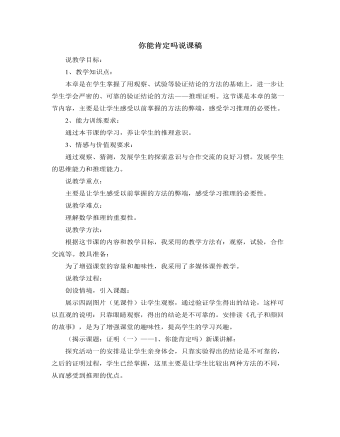
北师大版初中八年级数学上册你能肯定吗说课稿
探究活动二的安排,是要让学生明确只靠实验得出的结论,可能会以点带面,从而进一步说明学习推理的必要性。并小结出:如果要判断一个结论不正确只要举一个反例就可以了。探究活动三的安排是说明只靠实验得出的结论也不可靠,必须经过有根有据的推理才行。活动交流:(1)在数学学习中,你用到过推理吗?(2)在日常生活中,你用到过推理吗?这是一座桥梁,把课堂引向推理的方法。例题的安排,可以让学生学会简单的推理方法,同时增强学生的学习兴趣。课堂练习:①游戏:苹果在哪里?②判断:是谁打破玻璃?把练习变成游戏的形式,也是为了增加课堂的趣味性,提高学生的学习兴趣。课堂小结:进一步明确学习推理的必要性。课后作业:①课本习题6.1:2,3。②预习下一节:定义与命题
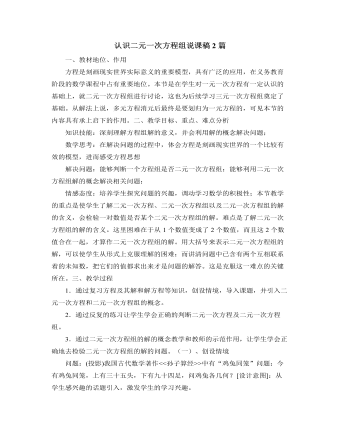
北师大版初中八年级数学上册认识二元一次方程组说课稿2篇
我们遇到的往往就是这样的方程组,我们要想比较简捷地把它解出来,就需要转化为同一个未知数系数相同或相反的情形,从而用加减消元法,达到消元的目的.请大家把解答过程写出来.解:①×3,得:6936xy??,③②×2,得:3486??yx,④③-④,得:2?y.将2?y代入①,得:3?x.根据上面几个方程组的解法,请同学们思考下面两个问题:(1)加减消元法解二元一次方程组的基本思路是什么?(2)用加减消元法解二元一次方程组的主要步骤有哪些?(由学生分组讨论、总结并请学生代表发言)[师生共析](1)用加减消元法解二元一次方程组的基本思路仍然是“消元”.(2)用加减法解二元一次方程组的一般步骤是:①变形----找出两个方程中同一个未知数系数的绝对值的最小公倍数,然分别在两个方程的两边乘以适当的数,使所找的未知数的系数相等或互为相反数.②加减消元,得到一个一元一次方程.③解一元一次方程.
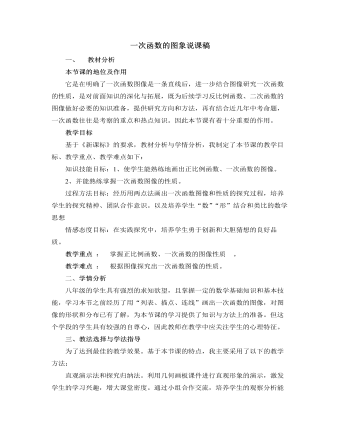
北师大版初中八年级数学上册一次函数的图象说课稿
[互动2]师:请大家从上面的解题经历中,总结一下如果已知函数的图象,怎样求函数的表达式?小组讨论之后再发表意见。生:第一步根据图象,确定这个函数是正比例函数或是一次函数;第二步设函数表达式;第三步:根据表达式列等式,若是正比例函数,只要找图象上一个点的坐标就可以了;若是一次函数,则需要找到图象上两个点的坐标,然后把点的坐标分别代入所设的解析式中,组成关于R、b的一个或两个方程。第四步:求出R、b的值第五步:把R、b的值代回到表达式中就可以了。师:分析得太好了。那么,大家说一说,确定正比例函数的表达式需要几个条件?确定一次函数的表达式呢?要说明理由。生:确定正比例函数需要一个条件,而确定一次函数需要两个条件。原因是正比例函数的表达式:y=Rx(R≠0)中,只有一个系数R,而一次函数的表达式y=Rx+b(R≠0)中,有两个系数(待定)R和b。

